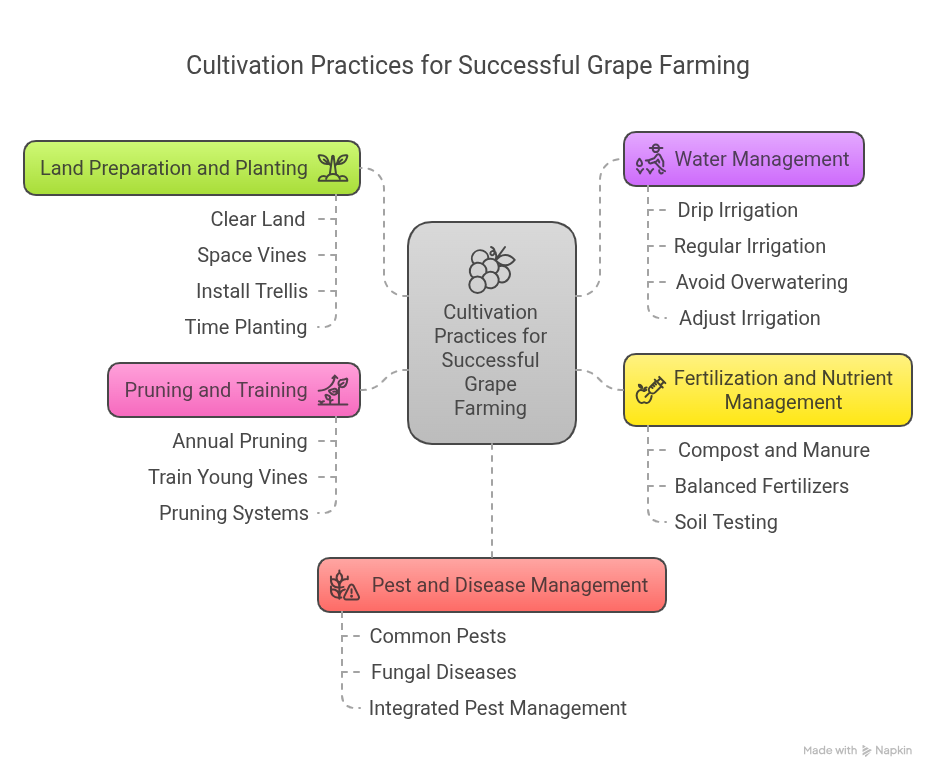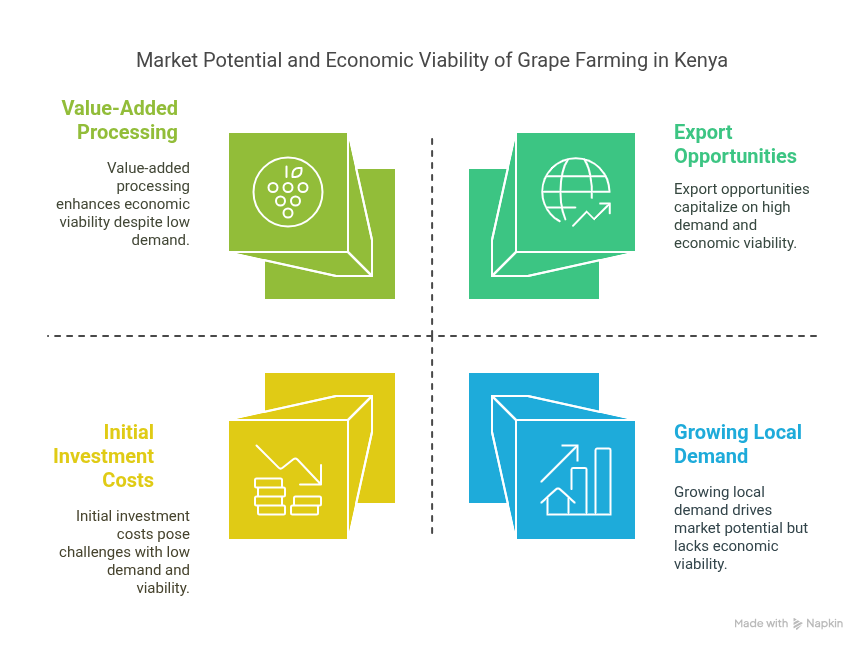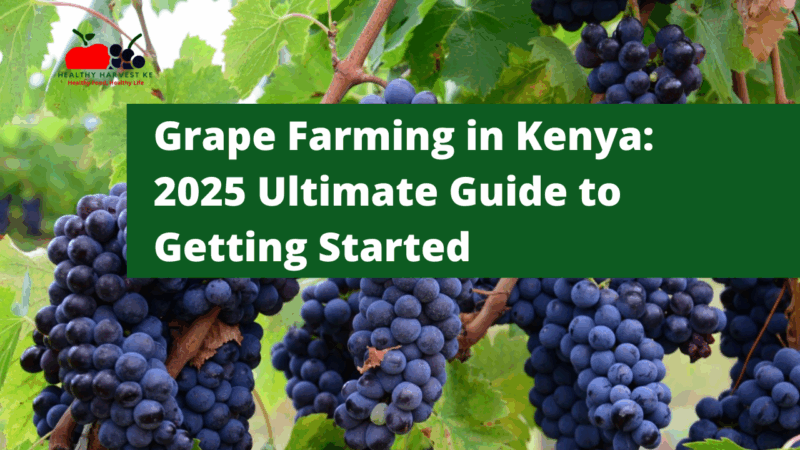Why Grape Farming in Kenya Makes Sense Right Now
Looking for an agricultural venture with serious profit potential in Kenya? Grape farming might just be your answer. Despite Kenya’s favorable growing conditions and increasing demand, we’re still importing a whopping 90% of our grapes. That’s a $60 million industry waiting for local farmers to step in.
The grape farming scene in Kenya has been quietly developing for over two decades, but it’s only recently catching fire as a viable commercial opportunity. With the market growing by an impressive 44% to reach $6.4 million in 2024, now’s the perfect time to consider adding these versatile fruits to your farming portfolio.
Whether you’re eyeing fresh table grapes, dreaming of starting a winery, or planning to produce raisins, this comprehensive guide will walk you through everything you need to know about grape farming in Kenya. Let’s dive in.
The History of Grape Cultivation in Kenya
Grape farming isn’t exactly new to Kenya – it dates back to the early 20th century when European settlers first introduced the crop. However, it’s only in recent decades that commercial cultivation has gained serious momentum.
Areas like Naivasha have been successfully growing grapes since around 2000, proving that this crop can thrive in our agricultural landscape. What’s interesting is that while many Kenyans have grapevines growing in their backyards (mostly as ornamental plants), the commercial sector remains relatively untapped – representing a multibillion opportunity for forward-thinking farmers.
Where Can You Grow Grapes in Kenya?
Not all regions in Kenya are suitable for grape farming, but several areas offer ideal conditions that mirror traditional grape-growing regions globally.
Ideal Regions for Grape Cultivation
- Rift Valley: Particularly areas around Naivasha and parts of Nakuru provide the perfect combination of warm days and cool nights that grape vines love. These temperature variations are crucial for developing the sugars and flavors that make quality grapes.
- Central Province: Offers suitable temperature variations and soil conditions that support grape growth.
- Eastern Province: Including areas around Meru, which has demonstrated consistent success in grape cultivation.
- Western Kenya: Bungoma has been identified as having appropriate conditions for certain grape varieties.

Most successful vineyards in Kenya are located at altitudes below 1,000 meters above sea level, creating the right microclimate for grape cultivation.
Climate Requirements
Grapes thrive in areas with specific climate characteristics:
- Warm, dry climates with distinct temperature variations between day and night
- At least 7-8 months of relatively dry conditions
- Consistent irrigation in hotter regions to supplement rainfall
- Areas that avoid heavy continuous rainfall (which can promote fungal diseases)
Soil Conditions
Your soil can make or break your grape farming venture. The ideal soil conditions include:
- Well-drained, slightly alkaline soils
- Loamy, sandy, or gravelly soils with adequate organic matter
- Somewhat sloping topography to prevent water logging
- Good drainage (crucial because grape roots are susceptible to rot in waterlogged conditions)
Popular Grape Varieties That Thrive in Kenya
Selecting the right grape variety is crucial for success in Kenya’s climate. Different varieties serve different purposes – some are perfect for fresh consumption (table grapes) while others are better suited for processing into wine.
Table Grape Varieties
Table grapes, meant for fresh consumption, are gaining popularity in Kenya due to their market potential:
- Thompson Seedless: A green seedless variety that thrives in Kenya’s climate and fetches good prices in both local and export markets.
- Red Globe: Known for its large, seeded red berries, this variety performs exceptionally well in several Kenyan growing regions.
The Ugandan Minister of Agriculture has specifically encouraged Kenyan farmers to focus more on table grape varieties due to their immediate market potential.
Wine Grape Varieties
If wine production is your goal, these varieties have shown promise in Kenya:
- French grapes (European origin): These are the most widespread type grown in Kenya.
- American grapes: Some varieties have adapted well to Kenyan conditions.
- Muscatine grapes: Another variety that has shown good adaptation to Kenyan cultivation.
Many Kenyan grape farmers initially focused on wine varieties, but there’s a growing trend toward table grapes due to their higher market value and immediate consumption potential.
Getting Started: Cultivation Practices for Successful Grape Farming
Now that you understand the basics, let’s get into the practical aspects of establishing and maintaining a productive vineyard in Kenya.
Land Preparation and Planting
Proper preparation lays the foundation for a thriving vineyard:
- Clear the land of weeds and debris, then plow deeply to loosen soil
- Space vines 2-3 meters apart to allow room for growth and maintenance
- Install a trellis support system – this is essential for grape vines to grow properly and maximize sun exposure
- Time your planting to coincide with the beginning of the rainy season to give young vines natural moisture as they establish
Water Management: The Key to Quality Grapes
Water management can make or break your grape harvest:
- Drip irrigation is considered ideal for grapevines as it provides consistent, targeted watering while conserving water
- During dry seasons, regular but careful irrigation is necessary
- Avoid overwatering as it can lead to root diseases and poor fruit quality
- Water requirements vary by growth stage – reduced irrigation is often beneficial during fruit ripening to concentrate flavors
Fertilization and Nutrient Management
Proper nutrition ensures healthy vines and optimal fruit production:
- Compost and well-rotted manure provide excellent organic matter to improve soil structure and fertility
- Apply balanced nitrogen, phosphorus, and potassium fertilizers to support different growth stages
- Conduct soil testing to determine specific nutrient requirements and prevent over-fertilization
Pruning and Training: Shaping Your Success
Regular pruning is essential for productive grape farming:
- Annual pruning promotes proper growth, airflow, and sun exposure
- Training young vines along the trellis helps establish the desired growth pattern
- Different pruning systems (cane pruning or spur pruning) can be used depending on your grape variety
Pest and Disease Management
Vigilance against pests and diseases is necessary to protect grape quality and yield:
- Common pests include aphids, which can be managed through biological controls or appropriate pesticides
- Fungal diseases such as powdery mildew are significant threats, especially in humid conditions
- Implement integrated pest management approaches that combine cultural practices, resistant varieties, and targeted treatments

Harvesting and Post-Harvest Handling
Knowing when and how to harvest is crucial for maintaining grape quality and maximizing market value.
When to Harvest
Grape vines typically begin producing harvestable fruit within 2-3 years after planting. Look for these indicators that grapes are ready for harvest:
- Full color development appropriate to the variety
- Appropriate sugar content (sweetness)
- Seeds that have turned from green to brown
- Slight softening of the berry
Harvesting is usually done by hand to prevent damage to the delicate fruit, especially for table grapes where appearance matters.
Post-Harvest Handling
Once harvested, grapes require careful handling:
- Cool table grapes quickly after harvest to remove field heat
- Use proper ventilated containers to prevent crushing and allow air circulation
- Utilize cold storage facilities to extend shelf life for market flexibility
- For wine production, ensure prompt processing after harvest to preserve quality
Market Potential and Economic Aspects
Now let’s talk about what makes grape farming in Kenya an exciting prospect – the market potential and economic benefits.
Growing Market Demand
The demand for grapes in Kenya continues to rise, driven by several factors:
- Expanding middle class with increasing disposable income
- Growing health consciousness and recognition of grapes’ nutritional benefits
- Rising interest in wine culture and local wine production
- Strong hospitality industry demand for quality fresh grapes
Export Opportunities
Kenyan grape farmers have begun exploring export markets:
- South Sudan is currently the main destination for Kenyan grape exports
- Democratic Republic of Congo and Uganda are also significant export markets
- Export volumes have shown significant growth in recent years, indicating expanding international opportunities
Economic Viability
Grape farming can be a profitable long-term investment:
- Fresh grapes can fetch over 400 Kenyan Shillings per kilogram in local markets
- A well-managed vineyard can remain productive and profitable for up to 30 years
- Value-added processing into wine, juice, or raisins can increase profitability
- Initial investment costs are offset by the long productive lifespan of grape vines

The Price of Success: Challenges in Grape Farming
Despite its potential, grape farming in Kenya comes with challenges that you should consider before diving in.
Pest and Disease Pressure
The warm climate that makes Kenya suitable for grape growing also creates favorable conditions for pests and diseases:
- Fungal infections like powdery mildew and downy mildew can be particularly problematic during humid periods
- Implementing effective integrated pest management strategies is essential but adds to production costs
Access to Quality Planting Materials
Historically, access to high-quality grape varieties and planting materials has been limited in Kenya. While the situation is improving with increased information sharing and agricultural extension services, obtaining certified disease-free planting stock remains challenging for some farmers.
Knowledge and Technical Expertise
Grape farming requires specialized knowledge that is still developing within Kenya’s agricultural sector:
- Proper trellising, pruning, irrigation management, and pest control all require technical expertise
- This knowledge may not be readily available to new farmers, requiring additional investment in training or expert consultation
Initial Investment Requirements
Establishing a vineyard requires significant upfront investment:
- Land preparation
- Trellising systems
- Irrigation infrastructure
- Quality planting materials
- The 2-3 year wait before the first harvest means farmers must have sufficient capital to sustain operations during the establishment period
Comparing Table Grapes vs. Wine Grapes Production
| Aspect | Table Grapes | Wine Grapes |
|---|---|---|
| Market Price | Higher per kg | Lower per kg but larger volume potential |
| Time to Market | Immediate after harvest | Requires processing time |
| Investment in Processing | Minimal | Substantial (winery equipment) |
| Value Addition | Limited | Significant through wine production |
| Storage Requirements | Cold storage needed | Can be processed immediately |
| Market Reach | Local and export markets | Primarily local with tourism potential |
Is Grape Farming in Kenya Right for You?
Grape farming in Kenya represents a promising agricultural opportunity with substantial market potential. With the country currently importing 90% of its grapes and the market growing by 44% to reach $6.4 million in 2024, there’s considerable room for expansion of local production.
Success in grape cultivation requires careful attention to variety selection, appropriate site preparation, and implementation of best practices in vineyard management. While challenges exist in terms of technical expertise and initial investment requirements, the long productive lifespan of vineyards (up to 30 years) provides an extended period for return on investment.
For enterprising farmers willing to invest in the necessary knowledge and infrastructure, grape farming offers a viable path to diversification and sustainable agricultural income in Kenya. As more Kenyan farmers gain experience with grape cultivation and share knowledge, this emerging agricultural sector is positioned for continued growth.
Are you already growing grapes in Kenya or considering starting? Share your experiences or questions in the comments below – we’d love to hear from you!
Ready to learn more about profitable farming ventures in Kenya? Explore our other comprehensive guides on high-value crops and subscribe to our newsletter for the latest agricultural insights.










